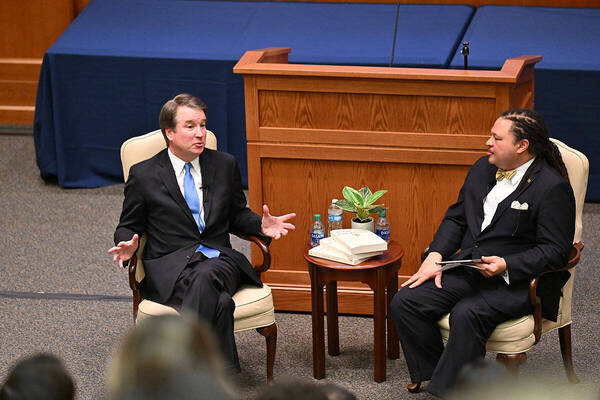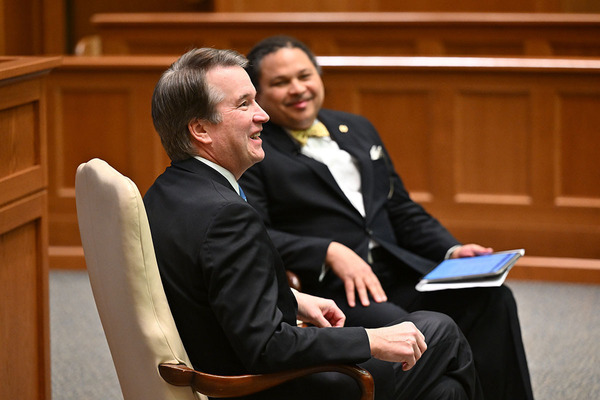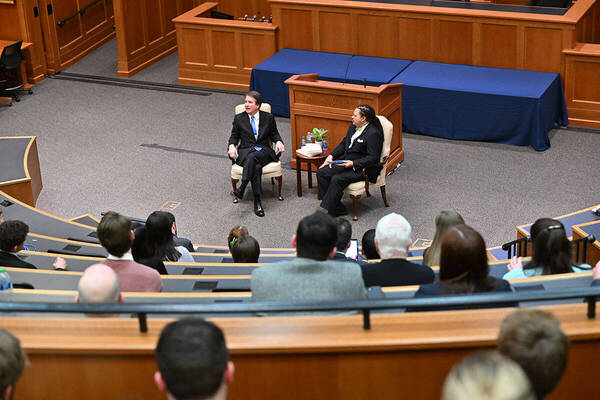ND Law Review symposium features Q&A with Supreme Court Justice Brett Kavanaugh
U.S. Supreme Court Associate Justice Brett Kavanaugh covered a range of topics during a talk at the Notre Dame Law Review Federal Courts Symposium on Monday, January 23, in the McCartan Courtroom.
Kavanaugh joined Notre Dame Law School Dean G. Marcus Cole at the symposium, and responded to questions on everything from how he looks at administrative law cases, to his relationships with his Supreme Court colleagues, to what he learned working for President George W. Bush. He even shared his opinion about whether the College Football Playoff should be expanded (he agreed it should).
A huge sports fan, his stories were frequently peppered with sports references. And his personal anecdotes often produced laughter from the over 180 students and faculty in attendance.
A theme woven into several of Kavanaugh’s responses was how he was formed by his Catholic education. While it is an honor to be a justice, he said, he sees it as more of a responsibility.

“How can I be as good as I can be at this job?” he asked, answering that he goes back to the foundations of his Catholic education.
He applies the lesson from his English teacher, particularly in discussion of the book To Kill A Mockingbird of the importance of standing in someone else’s shoes. Be well prepared. Stand in someone else’s shoes. Be not afraid. Those pivotal lessons have stood with him and ground him today.
“I think to be a good judge and a good person it is important to understand other people’s perspectives,” he said.
He said the Court needs to think about the 330 million people in the country with widely differing views on the big issues. He says while you aren’t going to please all the people all the time, the Court needs to try to understand their perspectives.
He said judges have to not be afraid to do the right thing despite the fact that they will be criticized. He compared that criticism to a referee or umpire who has to make the call that will lead to a negative reaction from the crowd.
While judges take a lot of criticism, he said, “Go to a high-school sports game and watch all the abuse referees take from the parents. Sometimes I think, who would want to do that job?” he laughed.
He spoke about the unique relationship the nine justices have, pointing out the enormous amount of time they spend with just those other eight people. It is a tradition that after they meet for oral argument or to discuss cases in conference, the judges all eat lunch together — about 65 times a year — and they can’t talk about work.
“That is a lot of lunches. So you talk about things that you do with other people in your life. We talk about our kids, movies, books, war stories ... again and again ... ,” said Kavanaugh. “You become friends.”

Kavanaugh commented about the spirit of compromise and the congeniality the judges have when assembling an opinion. Some cases will end in disagreement and in other cases they forge consensus. He provided perspective on the size of the docket saying there are many cases that don’t get a lot of attention, but are important. He said many of those cases don’t follow the typical pattern or perceived line of division that one might expect. Kavanaugh pointed to several cases last term where he joined the majority in 5-4 decisions written by Justices Stephen Breyer, Sonia Sotomayor, or Elena Kagan.
He said this further underscores how the justices work together. For example, he might be working in agreement with a particular judge on one case, and in disagreement on another case.
“I am not going to let the relationship in one case suffer because we might disagree on the other,” he said.
He said Justice Breyer, who retired last year, and the late Justice Ruth Bader Ginsburg were amazing at welcoming him to the Court. Six weeks after joining the Court in 2018, he joined the majority on a case where Justice Ginsburg was the senior justice. She asked him to write the majority opinion. He said yes, of course. He called Justice Kagan, who was his mentor for all things etiquette when he arrived at the Court, to ask if he did the right thing. She said yes, but to get the opinion out quickly, that “Ruth likes speed.” He said that was a great honor and a great moment for him.
He talked about his newest colleagues Justice Amy Coney Barrett, a 1997 graduate and longtime faculty member of Notre Dame Law School, calling her an unusually good person and superb judge; and Justice Ketanji Brown Jackson, who he says has hit the ground running and is always thoroughly prepared.
He has known Justice Neil Gorsuch since they were students together in high school and they both ended up clerking together for former Justice Anthony Kennedy. He remembered how they commented on what a big coincidence that was. “That turned out to be a pretty minor coincidence comparatively,” he said.
He touched on the various audiences justices consider when writing an opinion — their colleagues, the lower courts who have to apply the law, the affected parties, Congress, the American people — and on the importance of providing clarity in opinions.
He says his goal is for the losing party to understand why they disagree and feel that their arguments were treated fairly and with respect. He says a fair judge should test themselves. If the parties were flipped, would you do the same thing?

The Notre Dame Law Review’s Federal Courts Symposium centered on the topic of the Administrative Procedure Act. Kavanaugh answered questions about how he approaches APA cases, specifically how he applies the legal test set forth by the 1984 Supreme Court decision in Chevron v. NRDC. That case found that government agencies must conform to any clear legislative statements when interpreting and applying a law, but courts should give the agency deference in ambiguous situations as long as its interpretation is reasonable.
Kavanaugh said that he is a “footnote 9 Chevron person” referencing a footnote instruction that judges should apply all of the traditional tools of statutory construction in order to try to solve any ambiguity in the statute.
He said that he has applied it for 16 years, and has found that once you apply all of those tools, you usually get an answer.
Kavanaugh talked about the diversity of experiences the justices bring to the Court, and his experience working as the staff secretary for former President George W. Bush. He saw firsthand the enormous responsibility and demands put on a president. Bush took a large amount of criticism, he said. Yet, he saw how the president conducted himself and how he treated people, saying President Bush was always optimistic about the future, always very generous, and always great to his staff.
Kavanaugh says he is optimistic about the Court, the country, and his colleagues, all lessons he remembers from his time with President Bush.
Kavanaugh touched on the importance of law clerks and how, beyond academic marks and experience, he looks for clerks who can get along and be respectful with all of the Court’s chambers. Two Notre Dame Law School graduates, Alexa Baltes ’17 J.D. and Audrey Beck ’17 J.D., have served as clerks to Kavanaugh on the Supreme Court.
Kavanaugh said he was happy to be back at the Federal Courts Symposium, where he also participated in 2014 and 2017 while he was a judge on the U.S. Court of Appeals for the D.C. Circuit.
“It is wonderful to be back at Notre Dame,” he said. “This is one of the finest law schools in America, with spectacular faculty, and wonderful students.”
Watch the full recording of Justice Kavanaugh’s Q&A on Notre Dame Law School’s YouTube channel.